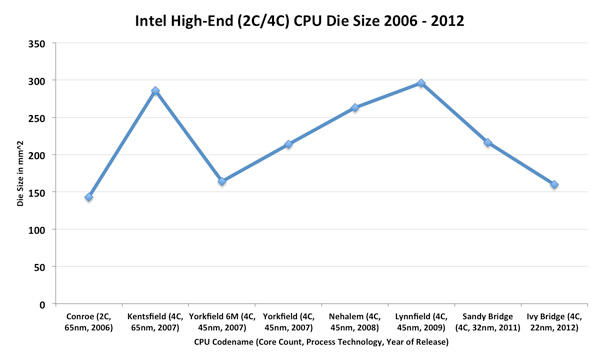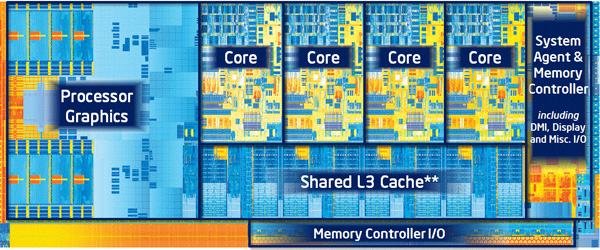The Intel Ivy Bridge (Core i7 3770K) Review
by Anand Lal Shimpi & Ryan Smith on April 23, 2012 12:03 PM EST- Posted in
- CPUs
- Intel
- Ivy Bridge
Die Size and Transistor Count
At IDF last year we got word of Ivy Bridge's transistor count (1.4 billion), however today we know its die size: 160mm2. That's 75% the size of a quad-core Sandy Bridge, but with 20% more transistors.
This marks the first time since 2006 that Intel is offering a high-end desktop CPU with this small of a die size. I'm excluding the 6-core parts from the discussion since that line isn't really aimed at the same market anymore. The chart is even more insane when you consider the Ivy Bridge die size includes an integrated GPU alongside four of the highest performance x86 cores Intel has ever shipped. Remove the GPU and Ivy Bridge is even smaller than Conroe. A hypothetical GPU-less Ivy Bridge would measure in at roughly 113mm^2 chip on its 22nm process, making it smaller than any high-end Intel CPU since the days of the Pentium 3.
| CPU Specification Comparison | ||||||||
| CPU | Manufacturing Process | Cores | Transistor Count | Die Size | ||||
| AMD Bulldozer 8C | 32nm | 8 | 1.2B | 315mm2 | ||||
| Intel Ivy Bridge 4C | 22nm | 4 | 1.4B | 160mm2 | ||||
| Intel Sandy Bridge E (6C) | 32nm | 6 | 2.27B | 435mm2 | ||||
| Intel Sandy Bridge E (4C) | 32nm | 4 | 1.27B | 294mm2 | ||||
| Intel Sandy Bridge 4C | 32nm | 4 | 1.16B | 216mm2 | ||||
| Intel Lynnfield 4C | 45nm | 4 | 774M | 296mm2 | ||||
| Intel Sandy Bridge 2C (GT1) | 32nm | 2 | 504M | 131mm2 | ||||
| Intel Sandy Bridge 2C (GT2) | 32nm | 2 | 624M | 149mm2 | ||||
Ivy Bridge is tiny—but what does this mean? For starters, it means the obvious—Intel has little competition in the desktop space. I'm always hard on AMD in my meetings with them because of this reason alone. A less than competitive AMD means we get a less aggressive Intel.
More importantly however, a tiny Ivy means that Intel could have given us a much bigger GPU without breaking the bank. I hinted at this possibility in our Ivy Bridge architecture article. Unfortunately at the time only Apple was interested in a hypothetical Ivy Bridge GT3 and rumor has it that Otellini wasn't willing to make a part that only one OEM would buy in large quantities. We will eventually get the GPU that Apple wanted, but it'll be next year, with Haswell GT3. And the GPU that Apple really really wanted? That'll be GT4, with Broadwell in 2014.
All of this being said however, we must keep in mind that Ivy Bridge is both faster than Sandy Bridge and no more expensive. If we look at the supply and pricing constraints that accompany TSMC's 28nm process, the fact that Intel is able to ramp up 22nm and ship the first products without any price increase is something we shouldn't take for granted.












173 Comments
View All Comments
bman212121 - Monday, April 23, 2012 - link
Does anyone know which motherboards are going to support VT-d? Is there a specific chipset you'll need to have or will it just be up to the vendor to decide?Thanks,
Bman
Magichands8 - Monday, April 23, 2012 - link
I feel so ambivalent about Intel's current strategy. I admit I really don't understand why laptops are moving ahead so significantly. Why on earth would someone want to buy a laptop to replace a home desktop system? And if they aren't doing that then how can Intel justify a move away from the high performance end of the spectrum? If you really need to do business work away from home AND away from work then I can see the need for the mobility that a laptop can provide but this focus on a gaming-centric platform so that people can one day soon play Crisis on their laptop at traffic stops on the way to work is utterly baffling to me. On the other hand, the process technology and architectural improvements we are seeing are amazing. It just burns me that performance for what I use a desktop for is essentially at a standstill now so that Intel can save this unfathomable laptop crowd a few watts during the occasional vacation. As it stands when I see a review like this at first I'm like "Oh wow!" and then I feel cheated for having waited for Intel's latest and greatest. Ivy Bridge-E and Haswell-E better be mind blowing or I'm going to be completely crestfallen at the direction that Intel is taking.Quantumbytes - Monday, April 23, 2012 - link
Intel is following a strategy that will in the end provide compute power for small and powerfull devices like cell phones, laptops, tablets, RFIDs, food and apparel tags, etc. They are looking at the big picture and the money is in the small designs. Desktops are a means to an end. Get used to the push to small and simple.JarredWalton - Monday, April 23, 2012 - link
Thanks for being an AMD apologist and reading with blinders. Trinity will probably maintain the GPU performance gap. Until Trinity arrives, however, IVB HD 4000 on laptops on average across 15 games is equal to Llano A8 on laptops.And what other things are people doing with graphics besides games? Video transcoding? Okay, there's one task. Name another that computer users do on a regular basis. [Crickets...]
So why is Intel putting so much effort into graphics? Because their business is to sell you a new microprocessor every 2-3 years if they can. With the ability to put 1.4 billion transistors into a 130mm^2 die, what else are they supposed to do? More cache? More CPU cores? You try to make the worst aspect of your product better, and then you market it to the masses. That's all that's really happening here.
frozentundra123456 - Monday, April 23, 2012 - link
Most Llano laptops I have seen are not even the A8 model, but mostly the A6, with somewhat lower graphics capabilities. So I think you are being very fair to AMD in comparing their top of the line graphics to HD4000, instead of the lower performance A6 graphics.André - Monday, April 23, 2012 - link
"Unfortunately at the time only Apple was interested in a hypothetical Ivy Bridge GT3 and rumor has it that Otellini wasn't willing to make a part that only one OEM would buy in large quantities. We will eventually get the GPU that Apple wanted, but it'll be next year, with Haswell GT3. And the GPU that Apple really really wanted? That'll be GT4, with Broadwell in 2014."Can't help but wonder were you got this tidbit from? :-)
Very interesting.
André - Monday, April 23, 2012 - link
D'oh ... spelling.Where you got the tidbit from even.
SC-D_E_A_T_H - Monday, April 23, 2012 - link
I'll be sticking with my AMD Sempron 3400+. A processing badass!DanNeely - Monday, April 23, 2012 - link
"How many enthusiasts who overclock their computers are going to be running them *at full load* 24/7? None. "I do. The 30W difference at stock would be ~$40/year directly (13c/kwh); and probably twice that indirectly since my LL pays for heat during the winter, but the AC bills all mine. Vs my current x58 boxes, probably another factor of 1.5-2x; although unless OC levels creep up over the next few months I'm tempted to just wait and hope haswell doesn't burn all its improvements on the IGP and lower TDP for mobile.
Malih - Monday, April 23, 2012 - link
Somehow I'm no longer hungering for the top performance CPU.CPU performance has somewhat exceed most people daily needs (and mine too), and mobile CPUs are more exciting today, especially if they can help the system to consume less battery and have better graphics. I think its now safe enough for manufacturer like for example Apple to go for Trinity instead of Ivy Bridge for their MB Air, provided Trinity can be made to consume minimal power.